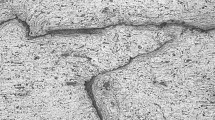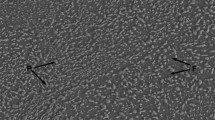Abstract
The thermomechanical treatment of HSLA-100 steel is undertaken to upgrade its properties. The plastic deformation in our study was done below and above the recrystallization temperature of austenite, as well in the two-phase (γ + α) region, followed by accelerated cooling. The plates were subsequently aged at two temperatures. The optical microstructures and hardness were done, and the effect of finish rolling temperature was established. The residual stress, X-ray elastic constants (XEC) and relative peak intensity were determined using X-ray diffraction. The effect of aging temperature on hardness, residual stress, Young's modulus, and Poisson's ratio was established. The residual stress values calculated using the XEC values obtained were found to be on the lower side compared to stress values using bulk elastic constants. The maximum difference in stress values is about 27%, which justifies the determination and use of XEC to obtain absolute values of stress.
Similar content being viewed by others
Reference
B. L. Bramfitt and J. G. Spear, A perspective on the morphology of bainite, Metall. Mater. Trans. A, 21A, p. 817(1990).
E. M. Focht, “Proc. Mater. Solution '97 on Accelerated Cooling/Direct Quenching of Steels”, ASM, OH, pp. 23–32 (1997).
E. J. Czyryca, Internal Report, DTRC-SME-90/21, David Taylor Research Centre, Bethesda, (1990).
M. R. Krishnadev, A. Laasraoui, K. Romhanyi, 'Processing, Microstructures and Properties of HSLA Steels', ed. A. J. DeArdo p. 261, 1988, TMS, PA.
E. G. Hamburg, A. D. Wilson, 'HSLA Steels: Processing, Properties & Applications', eds. G. Tither, Z. Shouhua, p. 2411992, The Minerals, Metals and Materials Society.
T. Tanaka, TMS-AIME Conf. Proc. on HSLA, eds. D. P. Dume and T. Chandra, pp. 6–16 1984.
M. E. Natishan, “Mechanisms of Strength and Toughness in a Microalloyed, Precipitation Hardened Steel”, David Taylor Research Centre Rep., Bethesda, SME–88–81 (April 1989).
R. K. Amin and F. B. Pickering, 'Thermo mechanical Processing of Microalloyed Austenite', eds. A. J. DeArdo, G. A. Ratz, and P. J. Wray, p. 377, 1982, AIME, Warrendale, PA.
Y. Zheng, A. J. DeArdo, R. M. Fix, and G. Fitzsimons, Intl. Conf. “Technology & Applications of HSLA Steels”, ASM pp. 85–94 (1983).
S. Zajac, T. Siwecki, B. Hutchinson, and M. Attlegard, Recrystallization controlled rolling and accelerated cooling for high strength and toughness in V-Ti-N steel, Metall. Trans. 22A, pp. 2681–2694 (1991).
A. J. Fletcher, Thermal Stress & Stress Generation in Heat Treatment, p. 42, 1989, Elsevier, London.
P. S. Prevey, A method of determining the elastic properties of alloys in selected crystallographic directions for X-ray diffraction residual stress, Adv. X-ray Anal. 20, pp. 345(1977).
R. M. Zhong, I. C. Noyan, J. B. Cohen, Adv. X-Ray Anal. 29, p. 17(1986).
T. Hanabusa, K. Nishioka and H. Fujiwara, Criterion for the triaxial X-ray residual stress analysis, Z. Metallkde. 74, p. 307(1983).
A. D. Krawitz, The use of X-ray stress analysis for WC-base cermets, Matl. Sci. Eng. 75, p. 29(1985).
A. D. Wilson, E. G. Hamburg, D. J. Colvin, S. W. Thompson, and G. Krauss, “Properties and Microstructures of Copper Precipitation Aged Plate Steels” Proc. Microalloy 88, World Mater. Congr. ASM, pp. 259–275 Sept. 1988.
H. J. Bunge and C. Esling, eds., Quantitative Texture Analysis, 1982, Deutsche Gesellschaft fur Metallkunde, Adenauerallee 21,6370 Oberursel 1, Germany.
P. J. Rudnik, A. D. Krawitz, D. G. Reichel, J. B. Cohen, Adv. X-Ray Anal. 31, p. 245(1988).
Society of Automotive Engineers, Residual Stress Measurements by X-ray Diffraction; SAE Handbook J784a, 2nd ed, 1971, SAE, New York.
Author information
Authors and Affiliations
Corresponding author
Rights and permissions
About this article
Cite this article
Bahadur, A., Kumar, B.R. & Chowdhury, S.G. Effect of Thermomechanical Treatment on X-Ray Elastic Constants and Residual Stresses in HSLA-100 Steel. Journal of Nondestructive Evaluation 22, 53–62 (2003). https://doi.org/10.1023/A:1026388426626
Issue Date:
DOI: https://doi.org/10.1023/A:1026388426626




